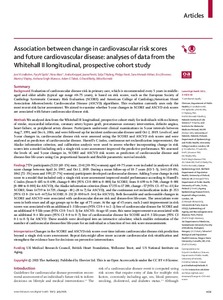Association between change in cardiovascular risk scores and future cardiovascular disease: analyses of data from the Whitehall II longitudinal, prospective cohort study
Ahmadi-Abhari Sara; Batty G. David; Brunner Eric J.; Frank Philipp; Kivimäki Mika; Knüppel Anika; Lindbohm Joni V.; Mars Nina; Nyberg Solja T.; Pentti Jaana; Shipley Martin J.; Singh-Manoux Archana; Sipilä Pyry N.; Tabak Adam G.
https://urn.fi/URN:NBN:fi-fe2021093048025
Tiivistelmä
Background
Evaluation of cardiovascular disease risk in primary care, which is recommended every 5 years in middle-aged and older adults (typical age range 40-75 years), is based on risk scores, such as the European Society of Cardiology Systematic Coronary Risk Evaluation (SCORE) and American College of Cardiology/American Heart Association Atherosclerotic Cardiovascular Disease (ASCVD) algorithms. This evaluation currently uses only the most recent risk factor assessment. We aimed to examine whether 5-year changes in SCORE and ASCVD risk scores are associated with future cardiovascular disease risk.
Methods
We analysed data from the Whitehall II longitudinal, prospective cohort study for individuals with no history of stroke, myocardial infarction, coronary artery bypass graft, percutaneous coronary intervention, definite angina, heart failure, or peripheral artery disease. Participants underwent clinical examinations in 5-year intervals between Aug 7, 1991, and Dec 6, 2016, and were followed up for incident cardiovascular disease until Oct 2, 2019. Levels of, and 5-year changes in, cardiovascular disease risk were assessed using the SCORE and ASCVD risk scores and were analysed as predictors of cardiovascular disease. Harrell's C index, continuous net reclassification improvement, the Akaike information criterion, and calibration analysis were used to assess whether incorporating change in risk scores into a model including only a single risk score assessment improved the predictive performance. We assessed the levels of, and 5-year changes in, SCORE and ASCVD risk scores as predictors of cardiovascular disease and disease-free life-years using Cox proportional hazards and flexible parametric survival models.
Findings
7574 participants (5233 [69 center dot 1%] men, 2341 [30 center dot 9%] women) aged 40-75 years were included in analyses of risk score change between April 24, 1997, and Oct 2, 2019. During a mean follow-up of 18 center dot 7 years (SD 5 center dot 5), 1441 (19 center dot 0%; 1042 [72 center dot 3%] men and 399 [27 center dot 7%] women) participants developed cardiovascular disease. Adding 5-year change in risk score to a model that included only a single risk score assessment improved model performance according to Harrell's C index (from 0 center dot 685 to 0 center dot 690, change 0 center dot 004 [95% CI 0 center dot 000 to 0 center dot 008] for SCORE; from 0 center dot 699 to 0 center dot 700, change 0 center dot 001 [0 center dot 000 to 0 center dot 003] for ASCVD), the Akaike information criterion ( from 17 255 to 17 200, change -57 [95% CI -97 to -13] for SCORE; from 14 739 to 14 729, change -10 [-28 to 7] for ASCVD), and the continuous net reclassification index (0 center dot 353 [95% CI 0 center dot 234 to 0 center dot 447] for SCORE; 0 center dot 232 [0 center dot 030 to 0 center dot 344] for ASCVD). Both favourable and unfavourable changes in SCORE and ASCVD were associated with cardiovascular disease risk and disease-free life-years. The associations were seen in both sexes and all age groups up to the age of 75 years. At the age of 45 years, each 2-unit improvement in risk scores was associated with an additional 1 center dot 3 life-years (95% CI 0 center dot 4 to 2 center dot 2) free of cardiovascular disease for SCORE and an additional 0 center dot 9 life-years (95% CI 0 center dot 5 to 1 center dot 3) for ASCVD. At age 65 years, this same improvement was associated with an additional 0 center dot 4 life-years (95% CI 0 center dot 0 to 0 center dot 7) free of cardiovascular disease for SCORE and 0 center dot 3 life-years (95% CI 0 center dot 1 to 0 center dot 5) for ASCVD. These models were developed into an interactive calculator, which enables estimation of the number of cardiovascular disease-free life-years for an individual as a function of two risk score measurements.
Interpretation
Changes in the SCORE and ASCVD risk scores over time inform cardiovascular disease risk prediction beyond a single risk score assessment. Repeat data might allow more accurate cardiovascular risk stratification and strengthen the evidence base for decisions on preventive interventions. Copyright (c) 2021 The Author(s). Published by Elsevier Ltd. This is an Open Access article under the CC BY 4.0 license.
Kokoelmat
- Rinnakkaistallenteet [19218]
